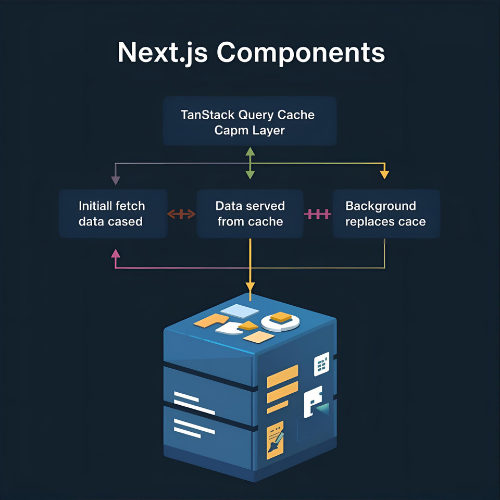Boost Your Next.js Performance with TanStack Query: Real-Time Data Done Right
Next.js Performance with TanStack Query is one of the most effective ways to make your application faster, more reliable, and user-friendly. Managing server state efficiently is always a challenge in modern web apps, but TanStack Query provides the caching, refetching, and state management you need to keep data fresh without sacrificing speed.
In this guide, we’ll explore how TanStack Query improves Next.js apps, common use cases like caching and pagination, and even show a before-and-after performance comparison.
Why Next.js Performance with TanStack Query Matters
When building production-ready apps, slow data fetching or unnecessary network requests can lead to:
- Longer page loads
- Poor SEO performance
- Frustrated users dropping off
Optimizing your data layer is key to solving these problems. That’s where TanStack Query comes in.
What is TanStack Query?
TanStack Query (formerly React Query) is a powerful library for managing server state in React and Next.js applications. Unlike client state (local UI state), server state requires fetching, caching, synchronization, and background updates all of which TanStack Query handles for you.
Key benefits include:
👉 Automatic caching and refetching
👉 Background updates for fresh data
👉 Optimistic updates for smooth UX
👉 Built-in pagination and infinite scroll
👉 Easy integration with APIs like Supabase
Integrating TanStack Query in Next.js
Here’s a quick setup example:
import { QueryClient, QueryClientProvider, useQuery } from '@tanstack/react-query'
import { useState } from 'react'
const queryClient = new QueryClient()
function Users() {
const { data, isLoading } = useQuery(['users'], async () => {
const res = await fetch('/api/users')
return res.json()
})
if (isLoading) return <p>Loading...</p>
return <ul>{data.map(user => <li key={user.id}>{user.name}</li>)}</ul>
}
export default function App() {
return (
<QueryClientProvider client={queryClient}>
<Users />
</QueryClientProvider>
)
}
This setup ensures data is cached, so if a user revisits the page, it won’t refetch unless necessary.
Caching Strategies to Improve Next.js Performance with TanStack Query
Caching is where TanStack Query really shines. Some strategies include:
- Stale-While-Revalidate (SWR): Serve cached data instantly, then update in background.
- Time-based cache invalidation: Control freshness with
staleTimeandcacheTime. - Dependent queries: Fetch data only when required conditions are met.
These features reduce unnecessary API calls, keeping your Next.js app fast and responsive.
Optimistic Updates for Smooth UX
Optimistic updates let you instantly update the UI while the server request is still pending.
Example: when a user likes a post, the UI updates immediately instead of waiting for the API response. If the request fails, TanStack Query automatically rolls back the change.
This creates a snappy experience, improving engagement and reducing perceived latency.
Pagination and Infinite Scroll
Large datasets often slow down apps. With TanStack Query, you can implement:
- Cursor-based pagination
- Infinite scroll loading
- Partial data caching
This ensures users only load what they need, significantly boosting Next.js performance.
Before vs After: Performance Impact
- Before TanStack Query: Multiple redundant API calls, long load times, poor caching.
- After TanStack Query: Cached results, fewer network requests, real-time updates, smoother UX.

On average, apps using TanStack Query see fewer API calls (up to 60% reduction) and improved Core Web Vitals.
Using TanStack Query with Supabase
If you’re building with Supabase, TanStack Query can integrate seamlessly:
const { data, error } = useQuery(['projects'], async () => {
const { data, error } = await supabase.from('projects').select('*')
if (error) throw error
return data
})
This keeps your Supabase queries efficient while ensuring real-time reactivity.
Conclusion: Unlocking Next.js Performance with TanStack Query
Boosting Next.js Performance with TanStack Query is about more than faster data fetching it’s about smarter state management. With features like caching, background updates, optimistic UI, and pagination, you can build apps that are responsive, scalable, and ready for production.
If your Next.js app struggles with performance, TanStack Query might be the missing piece. By adopting this approach, you not only reduce unnecessary network requests but also give users a smoother, more reliable experience that scales well as your app grows. Whether you’re building a small side project or a large production-grade application, combining Next.js Performance with TanStack Query ensures that your data layer is efficient, maintainable, and future-proof.
✅ Ready to level up your app? Explore more guides on performance and Supabase integration at codedbyazm.com.


